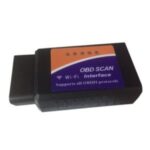Can you use a modern OBD2 scanner on an older OBD1 vehicle? The short answer is no, not directly. OBD1 and OBD2 systems are fundamentally different, utilizing distinct communication protocols and connector types. However, there are workarounds and adapters that can bridge the gap, allowing you to access some diagnostic information from your OBD1 car.
Understanding the Differences: OBD1 vs. OBD2
The key difference lies in how each system communicates with the vehicle’s computer. OBD2, standardized in 1996 for US vehicles, uses a standardized 16-pin connector and a digital communication protocol. This allows for consistent data retrieval across different makes and models. OBD1, on the other hand, predates this standardization. Different manufacturers used various connectors, protocols, and even proprietary software, making universal compatibility impossible.
Why You Can’t Directly Connect an OBD2 Scanner to an OBD1 Car
Attempting to plug an OBD2 scanner into an OBD1 port simply won’t work due to the incompatible connectors and communication methods. Forcing a connection could potentially damage both the scanner and the vehicle’s computer. OBD1 systems often rely on manufacturer-specific diagnostic tools and software.
Bridging the Gap: Adapters and Workarounds
While direct connection isn’t possible, there are options for retrieving diagnostic data from OBD1 vehicles:
-
OBD1 to OBD2 Adapters: These adapters physically connect to the OBD1 port and convert the signals to a format that an OBD2 scanner can understand. However, the functionality is often limited. You might only be able to access basic engine codes, and not all adapters are compatible with every make and model. Careful research is crucial to ensure compatibility with your specific vehicle.
-
Manufacturer-Specific Scan Tools: The most reliable method for diagnosing OBD1 vehicles is to use a scan tool specifically designed for that make and model. These tools are often more expensive but provide comprehensive access to all diagnostic data.
-
Aftermarket OBD1 Scan Tools: Some aftermarket companies offer scan tools designed for OBD1 vehicles. These tools may offer broader compatibility across different makes and models compared to manufacturer-specific tools.
Choosing the Right Solution for your OBD1 Vehicle
The best approach depends on your specific needs and budget. If you only require basic engine code reading, an OBD1 to OBD2 adapter might suffice. However, for more in-depth diagnostics, investing in a manufacturer-specific or a compatible aftermarket OBD1 scan tool is recommended.
Finding the OBD1 Connector on Your Vehicle
Locating the OBD1 connector can be challenging as its placement varied widely between manufacturers and models. Common locations include:
- Under the Dashboard: Often found on the driver’s side, near the steering column.
- Under the Hood: Check near the firewall or on the fender wells.
- In the Center Console: Some vehicles have the connector located inside the center console storage compartment.
- Consult Your Vehicle’s Manual: The owner’s manual is the best resource for locating the diagnostic connector on your specific car.
Conclusion
While using an OBD2 scanner directly on an OBD1 vehicle is not possible, there are solutions available. Adapters, manufacturer-specific tools, and aftermarket OBD1 scanners can provide access to diagnostic information. Choose the solution that best suits your needs and budget, and always research compatibility before making a purchase. Remember to consult your vehicle’s manual for the correct location of the diagnostic port.
